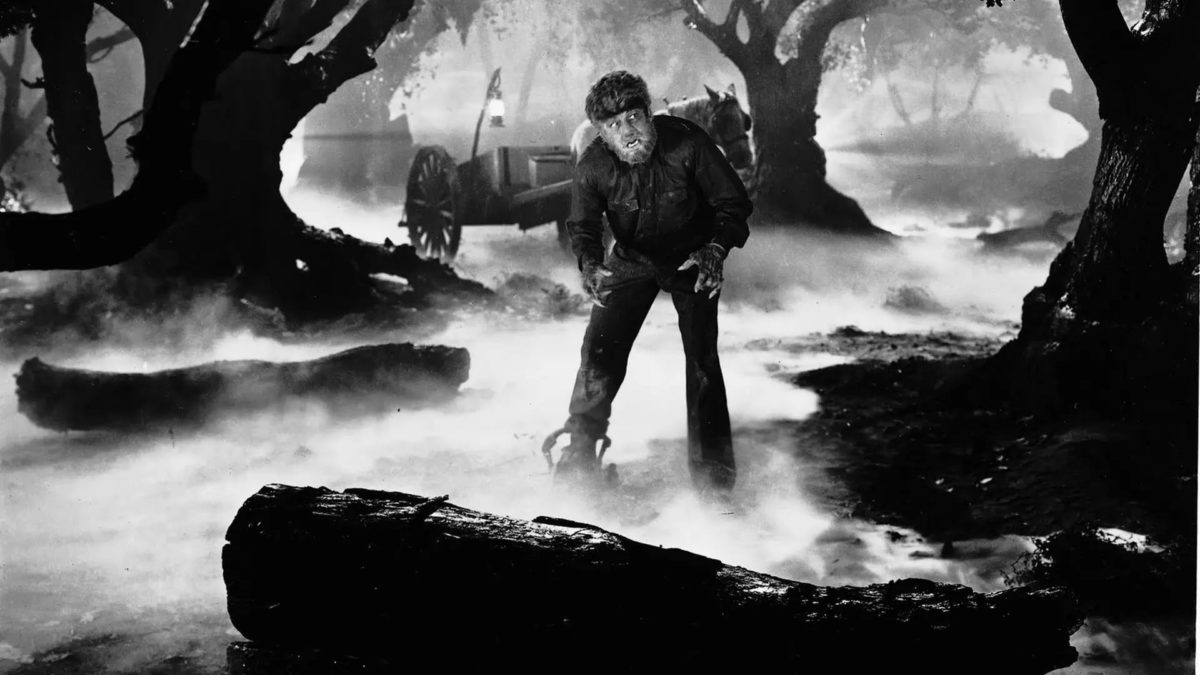Even a man who is pure in heart and says his prayers by night may become a wolf
The Wolf Man is not the first or most famous of the legendary Universal horror monster films. (It is not even, in fact, the first werewolf film in the series, as Werewolf of London came out six years earlier.) But The Wolf Man captures what that series of pictures were all about: sturdy, iconic tellings of horror creature tales in well-made studio system films that became the cultural standard image of the creature. Accordingly, The Wolf Man tells the quintessential werewolf story; most of the beats you know probably originate or were popularized here.
Unlike plenty of the other iconic Universal films, The Wolf Man is not based off a specific source novel, and many of the details that became werewolf tropes (e.g. the requirement of silver to slay a werewolf) were invented whole cloth by screenwriter Curt Siodmak for this outing. Thus, The Wolf Man offers even more historical value than many of its brethren.

The story follows Larry Talbot (Lon Chaney Jr.), an outsider who is wonderfully written and acted to be both sympathetic and sleazy in pretty equal measure. Talbot moves to his family’s manor in Wales, of which he becomes the heir following the death of his brother. The Welsh woods are frequented by gypsies and rumored to be haunted, and the whole neighborhood has an eerie aura. An opening title card warns of “lycanthropy” — a man turning into a wolf, rumored to happen in the area of Talbot’s hometown.
Talbot as rendered by Chaney has a friendly everyman aura about him, but his most notable traits are his rough edges. He peeps into the bedroom of a neighboring woman named Gwen (Evelyn Ankers), then tries to manipulate her into a date. He refuses to accept her “no” and practically ambushes her to take her for a walk in the woods. He pouts when she brings along her friend Jenny (Fay Helm) and seems totally unfazed when she shares that she’s engaged to the wholesome Frank (Patric Knowles).
These character flaws actually make Talbot a more compelling werewolf. His transformation from man to monster following a bite is just an unhinged exacerbation of what we’ve seen within him. The excellent screenplay by Siodmak, despite being a bit bogged down with old-fashioned psychology jargon, does a great job of probing how Talbot is suffering from a downward mental health spiral even separate from his wolf problems — his lycanthropy and misanthrophy amplify each other. There’s also a touch of sexual frenzy and degeneracy to the way the wolfmen stalk after young women. (The puberty metaphor often associated with werewolves in the future doesn’t quite fit given that Talbot looks a schleppy thirty-something. Speaking of familiar missing totems, the full moon as trigger isn’t used either.)

I haven’t yet mentioned the production values, which are overall terrific. This is A-picture quality photography and production design: Lots of moody smoke, expressionistic compositions, gothic architecture, and engaging sets in churches and the woods. Buckets of spooky atmosphere. On the other hand, I think the wolf costume and makeup itself is a bit underwhelming — he looks like an especially hairy man with some brown face paint rather than something genuinely lupine and monstrous. To some extent this extends the film’s theme that real monstrosity comes from Talbot’s human nature, not his wolf curse. But I think that’s a cop-out — it’s just not all that cool or iconic compared to Universal’s best of the era, and we really could have used a couple more scenes featuring Talbot in full wolf form. We get just two real werewolf chases, and they’re so drenched in shadows and trees that they’re more of a suggestion of a wolf stalking.
The cast is overall quote good, with no real weak links. I didn’t quite buy Gwen’s affectionate turn towards Talbot towards the end of the film, seemingly validating his problematic traits, but that’s more on the writing than Ankers. One special highlight is a woods-wandering gypsy named Bela played by, you guessed it, Bela Lugosi.
The Wolf Man is a really wonderful little horror film: handsomely constructed, dripping with horror flavor, and thoughtful about its monster and it how it echoes the psychology of the protagonist. At 72 minutes, it whizzes by, a bit slight but extremely satisfying. Overall, a great way to kick off spooky season.
Is It Good?
Very Good (6/8)
Dan is the founder and head critic of The Goods. Follow Dan on Letterboxd. Join the Discord for updates and discussion.


3 replies on “The Wolf Man (1941)”
Of the “first batch”–and as I guess it’s technically of the second batch (Dracula’s Daughter, Son of Frankenstein, The Invisible Man Returns, and The Mummy’s Hand had all come out) so the “classic ones,” if I must–this one winds up in the middle and maybe even the bottom of the middle. But it’s awesome that this (almost*) represents a floor for the classic eight, I really like it.
*I think I might rewatch it for October, but Dracula’s just no good.
I’m sure you read between the lines in this review that I’ve only seen a couple of these. I really need to see more. Maybe a binge is in order.
Ah, I didn’t quite catch that. I still need to watch all of the Invisible Man sequels, and of the Abott & Costellos I’ve only seen Meet the Mummy.
You gotta see The Invisible Man, The Mummy, and the first two Frankensteins, and Black Lagoon. There’s some good stuff otherwise, but no reason except completism to see *any* of the “real” Mummy sequels, they’re literally all bad. Just skip to the Hammer films on that, and I’m not even a big Hammer-head.